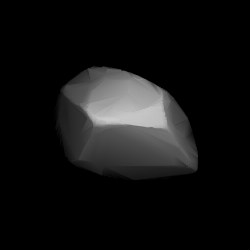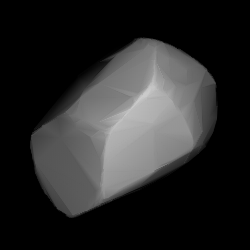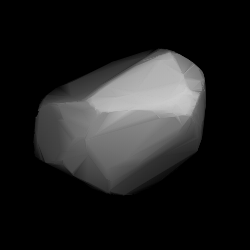2069 Hubble, provisional designation 1955 FT, is a carbonaceous asteroid from the outer region of the asteroid belt, approximately 40 kilometers in diameter. It was discovered on 29 March 1955, by the Indiana Asteroid Program at Goethe Link Observatory, United States, and named after American astronomer Edwin Hubble.

1743 Schmidt, provisional designation 4109 P-L, is a dark background asteroid from the inner regions of the asteroid belt, approximately 19 kilometers in diameter. It was discovered during the Palomar–Leiden survey on 24 September 1960, by astronomers Ingrid and Cornelis van Houten at Leiden, on photographic plates taken by Tom Gehrels at Palomar Observatory in California. The C-type asteroid has a rotation period of 17.5 hours. It was named for the optician Bernhard Schmidt.
1096 Reunerta, provisional designation 1928 OB, is an asteroid from the background population of the asteroid belt's central region, approximately 40 kilometers in diameter. It was discovered on 21 July 1928, by astronomer Harry Edwin Wood at the Union Observatory in Johannesburg, South Africa. The asteroid was named after South African engineer Theodore Reunert, supporter of the observatory and friend of the discoverer.

1118 Hanskya is a large background asteroid, approximately 77 kilometers in diameter, located in the outer regions of the asteroid belt. Discovered by Sergey Belyavsky and Nikolaj Ivanov in 1927, it was named after Russian astronomer Aleksey Hansky. The presumed dark C-type asteroid has a rotation period of 15.6 hours.

1127 Mimi is a dark background asteroid from the central regions of the asteroid belt. It was discovered on 13 January 1929, by Belgian astronomer Sylvain Arend at the Royal Observatory of Belgium in Uccle. The carbonaceous C-type asteroids (CX) has a rotation period of 12.7 hours and measures approximately 47 kilometers in diameter. Through a glitch in the naming process, the asteroid received the name "Mimi" instead of "Robelmonte" as originally intended by the discoverer.

1147 Stavropolis is a stony background asteroid from the inner regions of the asteroid belt. It was discovered on 11 June 1929, by Georgian–Russian astronomer Grigory Neujmin at the Simeiz Observatory on the Crimean peninsula. The S-type asteroid has a rotation period of 5.7 hours and measures approximately 14 kilometers in diameter. It was named after the Russian city of Stavropol.

1294 Antwerpia (prov. designation: 1933 UB1) is a dark background asteroid from the central regions of the asteroid belt. It was discovered on 24 October 1933, by astronomer Eugène Delporte at the Royal Observatory of Belgium in Uccle. The carbonaceous C-type asteroid has a rotation period of 6.6 hours and measures approximately 35 kilometers (22 miles) in diameter. It was named for the Belgian city of Antwerp.

1275 Cimbria is a Eunomia asteroid from the central regions of the asteroid belt, approximately 27 kilometers in diameter. It was discovered on 30 November 1932, by astronomer Karl Reinmuth at the Heidelberg-Königstuhl State Observatory in southern Germany. The asteroid was named after the Cimbri, an ancient Germanic tribe.

1555 Dejan, provisional designation 1941 SA, is an asteroid from the background population of the central regions of the asteroid belt, approximately 22 kilometers in diameter. It was discovered on 15 September 1941, by Belgian astronomer Fernand Rigaux at the Royal Observatory of Belgium in Uccle. The asteroid was named after Dejan Đurković, son of Serbian astronomer Petar Đurković.
2126 Gerasimovich, provisional designation 1970 QZ, is a stony background asteroid from the inner regions of the asteroid belt, approximately 8 kilometers in diameter. It was discovered on 30 August 1970, by Soviet astronomer Tamara Smirnova at the Crimean Astrophysical Observatory in Nauchnyj, on the Crimean peninsula. The asteroid was named after Russian astronomer Boris Gerasimovich.
1271 Isergina, provisional designation 1931 TN, is a carbonaceous background asteroid from the outer regions of the asteroid belt, approximately 45 kilometers in diameter. It was discovered on 10 October 1931, by Soviet astronomer Grigory Neujmin at the Simeiz Observatory on the Crimean peninsula. The asteroid was named after Crimean physician and friend of the discoverer, Pyotr Isergin.
6255 Kuma, provisional designation 1994 XT, is a carbonaceous asteroid from the central region of the asteroid belt, approximately 22 kilometers in diameter. It was discovered on 5 December 1994, by Japanese astronomer Akimasa Nakamura at Kuma Kogen Astronomical Observatory on the Island of Shikoku, Japan. It was named after the Japanese town of Kumakōgen.
1303 Luthera, provisional designation 1928 FP, is a dark asteroid and the parent body of the Luthera family, located in the outermost regions of the asteroid belt. It measures approximately 90 kilometers in diameter. The asteroid was discovered on 16 March 1928, by astronomer Friedrich Schwassmann at the Bergedorf Observatory in Hamburg, Germany, and later named after German astronomer Robert Luther.

1332 Marconia, provisional designation 1934 AA, is a dark asteroid and the parent body of the Marconia family located in the outer regions of the asteroid belt. It measures approximately 46 kilometers in diameter. The asteroid was discovered on 9 January 1934, by Italian astronomer Luigi Volta at the Observatory of Turin in Pino Torinese, northern Italy. It was named for Italian electrical engineer Guglielmo Marconi. The uncommon L-type asteroid has a rotation period of 19.2 hours.

4547 Massachusetts is a dark background asteroid from the central regions of the asteroid belt, approximately 24 kilometers in diameter. It was discovered on 16 May 1990, by Japanese astronomers Kin Endate and Kazuro Watanabe at the JCPM Sapporo Station on the island of Hokkaido, Japan. The asteroid was named for the U.S. state of Massachusetts.
2043 Ortutay, provisional designation 1936 TH, is a dark asteroid from the outer regions of the asteroid belt, approximately 45 kilometers in diameter. The asteroid was discovered by Hungarian astronomer György Kulin at the Konkoly Observatory, Budapest, on 12 November 1936. It was named after Hungarian ethnographer Gyula Ortutay.

1493 Sigrid, provisional designation 1938 QB, is a dark Nysian asteroid from the inner regions of the asteroid belt, approximately 24 kilometers in diameter. It was discovered on 26 August 1938, by Belgian astronomer Eugène Delporte at the Royal Observatory of Belgium in Uccle. It was named after Sigrid Strömgren, wife of astronomer Bengt Strömgren.

1407 Lindelöf, provisional designation 1936 WC, is an asteroid from the central region of the asteroid belt, approximately 20 kilometers in diameter. It was discovered on 21 November 1936, by Finnish astronomer Yrjö Väisälä at Turku Observatory in Southwest Finland. The asteroid was named after Finnish topologist Ernst Lindelöf.
1259 Ógyalla, provisional designation 1933 BT, is a Themistian asteroid from the outer region of the asteroid belt, approximately 32 kilometers in diameter. It was discovered on 29 January 1933, by German astronomer Karl Reinmuth at Heidelberg Observatory in southwest Germany. The asteroid was named for the Hurbanovo Observatory.
1708 Pólit, provisional designation 1929 XA, is a very dark asteroid from the outer region of the asteroid belt, approximately 29 kilometers in diameter. It was discovered on 30 November 1929, by Spanish astronomer of Catalan origin Josep Comas i Solà at the Fabra Observatory in Barcelona, and was later named after Catalan astronomer Isidre Pòlit i Boixareu.











